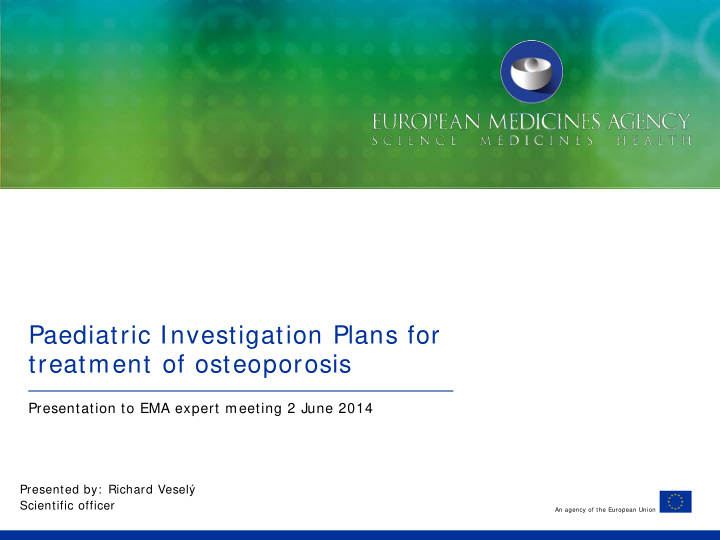



Paediatric Investigation Plans for treatment of osteoporosis Presentation to EMA expert meeting 2 June 2014 Presented by: Richard Veselý Scientific officer An agency of the European Union
The European Medicines Agency (EMA) 7, Westferry Circus Canary Wharf London E14 4HB United Kingdom www.ema.europa.eu 1
The European Medicines Agency (EMA) 30 Churchill Place Canary Wharf 2
The EMA Mission… is to foster scientific excellence, for the benefit of public and animal health. Guiding principles We are strongly committed to public and animal health. We support research and innovation to stimulate the development of better medicines. Gatekeeper and Enabler 3
The European Medicines Agency (EMA) EMA is an interface for co-operation and co-ordination of Member States’ activities with respect to medicinal products EMA scientific work is carried out through its scientific committees • CHMP (Committee for Human Medicinal Products) • CVMP (Committee for Veterinary Medicinal Products) • HMPC (Committee for Herbal Medicinal Products) • COMP (Committee for Orphan Medicinal Products) • CAT (Committee for Advanced Therapy Medicinal Products) • PDCO (Paediatric Committee) • PRAC (Pharmacovigilance & Risk assessment Committee) 4
Agency activities • Management of the Centralised Procedure • Human and veterinary, chemical and biological products • Evaluation of new products, generics, OTCs • Scientific advice and protocol assistance to companies • Orphan drugs designation • Review of Paediatric Investigation Plans (PIP) • Regulatory & scientific guidance (guidelines) to companies • Support to Small and Medium Sized companies (SMEs) • Arbitration and referral procedures for national medicines • Coordination of EU pharmacovigilance activities • Coordination of Member States’ inspections (GMP, GCP, GLP) 5
REGULATION (EC) No 1901/2006 OF THE EUROPEAN PARLIAMENT AND OF THE EU Paediatric Regulation COUNCIL of 12 December 2006 on medicinal products for paediatric use and Entry into force 26 January 2007 amending Regulation (EEC) No 1768/92, Directive 2001/20/EC, Directive 2001/83/EC and Regulation (EC) No 726/2004 Objectives: Improve the health of children • Increase high quality, ethical research into medicines for children • Increase availability of authorised medicines for children • Increase information on medicines Achieve the above • Without unnecessary studies in children • Without delaying authorisation for adults 6
General authorisation requirements Article 7 • (a) the results of all studies performed and details of all information collected in compliance with an agreed paediatric investigation plan ; (b) a decision of the Agency granting a product-specific w aiver ; (c) a decision of the Agency granting a class waiver pursuant to Article 11; (d) a decision of the Agency granting a deferral. • The documents submitted pursuant to paragraph 1 shall, cumulatively, cover all subsets of the paediatric population. 7
Paediatric investigation plan Article 15 The paediatric investigation plan shall specify • the tim ing and the m easures proposed to assess the quality, safety and efficacy of the medicinal product • in all subsets of the paediatric population that may be concerned. In addition, it shall describe any measures • to adapt the form ulation of the medicinal product so as to make its use more acceptable, easier, safer or more effective for different subsets of the paediatric population. 8
Waiver Article 11 Grounds for w aiver: (a) that the specific medicinal product or class of medicinal products is likely to be ineffective or unsafe in part or all of the paediatric population; (b) that the disease or condition for which the specific medicinal product or class is intended occurs only in adult populations; (c) that the specific medicinal product does not represent a significant therapeutic benefit over existing treatments for paediatric patients. 9
EMA = A Networking Agency • National competent authorities in 28 Member States • Agency is an interface of co-operation and co-ordination of Member States’ activities with respect to medicinal products • European experts’ netw ork underpins the work of the Agencies’ Committees (6) and working parties • Expert list of 4,900 nominated experts • European Commission, European Parliament, other EU agencies (ECDC, EFSA), European Pharmacopoeia … 10
Clinical and regulatory guidelines –different universes? Need to overcome discrepancies • Not identical • Collaboration scope • Mutual learning, • Potentially exchange of different expertise approach 11
Condition vs. indication CHMP opinion is on the indication , consequently indication is authorised. PDCO opinion is on the condition 12
How the PIP condition is identified? 1. Proposed indication in adults 2. Properties of the product (mechanism of action) 3. Unmet paediatric needs 4. Hierarchical classification of diseases 5. Treatment, prevention or diagnosis of the disease 13
Condition: Treatment of osteoporosis Proposed indications in adults: Treatment of postmenopausal osteoporosis (class waiver revoked in April 2009) Treatment of male osteoporosis Treatment of primary osteoporosis Treatment of secondary osteoporosis (e.g. GIOP… ) I ndications in children: Treatment of glucocorticoid induced osteoporosis Treatment of osteogenesis imperfecta 14
Agreed PIPs and waivers in treatment of osteoporosis PI Ps: W aivers: Zoledronic acid Lasofoxifene Odanacatib Arzoxifene Denosumab Strontium Bazedoxifene/ Conjugated estrogens Teriparatide Calcitonin Alendronic acid/ colecalciferol 15
Feasility issues identified 1. Decrease in the use of corticosteroid treatment in paediatric patients with IBD and chronic rheumatologic conditions 2. Difficulties related to recruitment of paediatric patients with osteoporotic fractures 3. Refusal to enter the study due to the placebo treatment arm 16
Guidelines http: / / www.ema.europa.eu/ docs/ en_GB/ docum http: / / www.ema.europa.eu/ docs/ en_GB/ doc ent_library/ Scientific_guideline/ 2009/ 09/ WC500 ument_library/ Scientific_guideline/ 2012/ 10/ 003405.pdf WC500134467.pdf 17
Recommend
More recommend